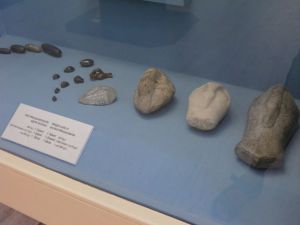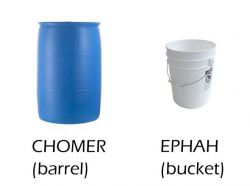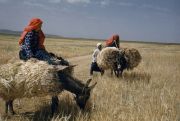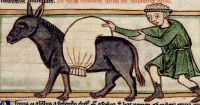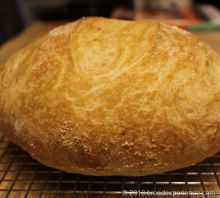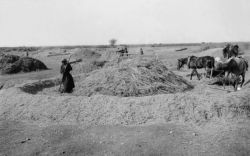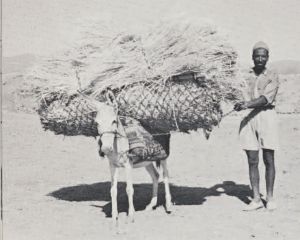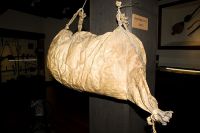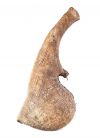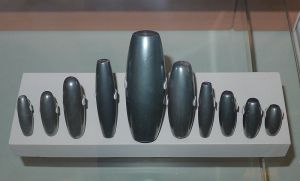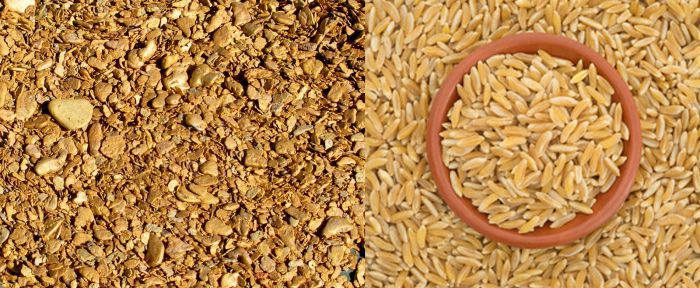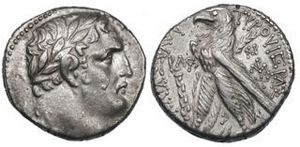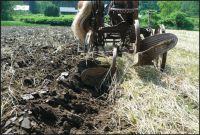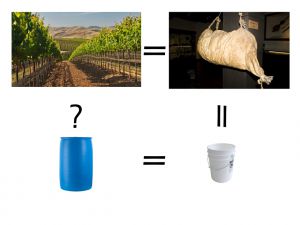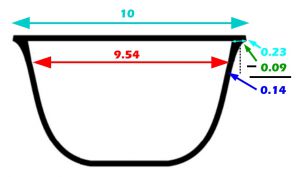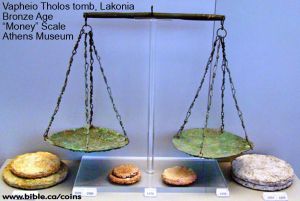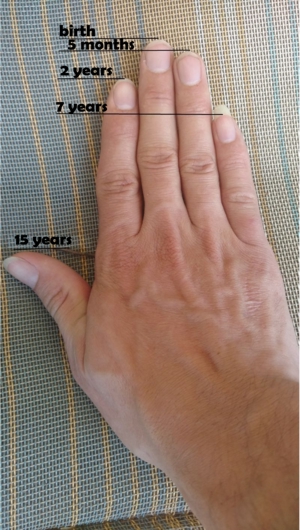The Meanings of the Measures
The world sees everything God does as disconnected, random, and haphazard. In fact, everything God does is part of a single plan, stemming from a single idea that we are “without excuse” for not understanding.
The measurements in the Bible are like that. In our defense, we do not live on farms, or work with whole grains, or plow fields using oxen. So some of these things would have been a lot easier to understand for your typical Israelite under David than they are for us today – but it didn’t seem to help, for even those people were constantly missing point. “It is because we have no bread!” they said, as Jesus shook His head and sighed.
To understand the truth you must approach it believing it can be understood, that it makes sense, and that it was meant to be understood. That’s what I’ve done with these measurements in the Bible, and what do you know – they make sense.
Contents
- 1 Ancient Measuring
- 2 A Perfect System
- 3 Chomers
- 4 The Omer
- 5 Loaves
- 6 Omers And Chomers
- 7 Ephah And Bath
- 8 The Hin
- 9 Talents
- 10 Maneh
- 11 Manna And Maneh?
- 12 Historical Shekels
- 13 Cubit
- 14 Hands Per Cubit
- 15 Area
- 16 Acres Per Chomer
- 17 The Final Test
- 18 Different Talents
- 19 The Value Of A Field
- 20 Tithing
- 21 Seahs
- 22 The Hire Of A Labourer
- 23 A Handbreadth
- 24 Smaller Than Shekels
- 25 The Omer In The Ark
- 26 Weighed In The Balances
- 27 Treasure In Heaven
- 28 Golden Talent
- 29 A Web Of Connections
- 30 Summary And Conclusion
- 31 Notes
Ancient Measuring
Every measuring system requires three basic measurements: distance – feet/meters; weight – pounds/kilograms; and volume – gallons/liters. Some systems also have a fourth unit, to divide wet volume measurements from dry.
Leviticus 19:36 Just balances, just weights, a just ephah, and a just hin, shall ye have…
Until about 100 years ago, pretty much everyone relied on one simple method for measuring weights – the balance. Two baskets connected by a bar are placed on a pivot until they precisely line up – then the product you are buying is placed in one basket, and on the other side units of known weight are added, until they balance. Then you know exactly what you owe the seller.
The process is repeated for the payment, with a lead or stone weight, known to be exactly, say, an ounce, on one side of the balance against the required amount of silver. When it balances perfectly, the seller takes it, and you take your goods and the deal is done.
God commands just balances and just weights – for if the balance itself is crooked, the weights won’t level out at an even weight – and you’ll have to give more silver to make it balance! Likewise, if the weight that says “one ounce” is actually a little heavier, it will take more silver to make it balance – thus cheating the customer!
Most governments, instead of having official coinage, put out official weights, carved in the shape of a duck or a lion, which merchant and customer alike could trust, like these Babylonian weights.
Sometimes they use units stamped with a trusted symbol, like the symbol of the merchants of Tyre (Genesis 23:16 for instance). The key is that both buyer and seller must trust that this is a “real” ounce.
This is vitally important because they did not have money as we understand the term until around 700 BC. Before then they used silver and gold as a medium of exchange, but it was not in a convenient coin with a value stamped on it. Instead, each transaction involved a specified weight of silver or gold.
This weight could be provided in nuggets, jewelry, or melted pieces of precious metal, but it was not true money as we think of it. Today we measure our wealth in dollars, pesos, euros, whatever. If we have none, we are broke – we cannot pay for gas with grain, nor buy a shirt with a dozen eggs. We MUST have money in order to do business, having GOODS is not good enough.
This is a relatively modern idea; the fact is, if you have a warm place to sleep, clothes to wear, and plenty to eat – without having to kill yourself to grow it – you’re rich, even if you never see a dollar or a piece of silver.
This is why I said they did not have money as we understand it. Silver and gold were merely used as a “medium” of trade, meaning that it often did not actually change hands, it was simply the abstract way of valuing your goods for direct trade. These assets – eggs, wheat, figs were traded as if they were silver.
For example, my bucket of dates is worth an ounce of silver, your ounce of cinnamon is worth two ounces of silver. So I trade you two buckets of dates for your ounce of cinnamon. Silver never actually changed hands here, it was simply the medium of exchange. This is how most trade in history was done.
When you worked for a farmer to harvest wheat, rather than haul all the wheat to market, trade it for silver, pay you in silver, just so you can go back to the same market and buy wheat… you simply get paid in wheat!
This is a better deal for both of you, because the farmer sells it wholesale, and you have to pay retail – so money is lost in the process, given to a third person who doesn’t really contribute to society’s wealth, just moves it around. Why do that, when you could both have more wealth with a direct trade, the farmer paying less for work, you getting paid more for your work?
Money is used in the Bible, and it has a function. Mostly for travel, or buying luxuries from far away (Deuteronomy 14:23-26). The word translated “money” in the Bible is usually Hebrew “keseph” which literally means “silver”. Ideally, you ate your actual tithe of wine, oil, lambs, and so on. But if the place was too far away, you sold those tithes for silver, and brought the silver to the feast, then bought new tithes with that.
Deuteronomy 14:23-26 And thou shalt eat before the LORD thy God, in the place which he shall choose to place his name there, the tithe of thy corn, of thy wine, and of thine oil, and the firstlings of thy herds and of thy flocks; …And if the way be too long for thee, so that thou art not able to carry it; …Then shalt thou turn it into money, and bind up the money in thine hand, and shalt go unto the place which the LORD thy God shall choose: And thou shalt bestow that money for whatsoever thy soul lusteth after, for oxen, or for sheep, or for wine, or for strong drink, or for whatsoever thy soul desireth…
In small communities – which is what existed through most of the Bible – money is an abstract concept used to value commodities between people who know each other, because at the end of the day, you can’t EAT silver. It has no real, inherent value. You can eat bread, dates, and oil. Why would you trade for silver, when you could trade for things you actually need?
But to trade fairly, you must have some standard of measuring; some way of quantifying your dates, of weighing your silver, of measuring your land. A system that anyone can check, that everyone can trust and most importantly – a system that reveals the plan of God.
A Perfect System
The American and British system of weights and measures mystifies the rest of the world. It really is an inefficient system, because there is no real connection between weight and volume, or volume and length. Plus, each different unit has a different number of sub-units – 16 ounces to a pound, but 2,000 pounds to a ton; 12 inches to a foot, 3 feet in a yard; 1,000 yards is not a special unit, but 5,280(!) feet is a mile…
Then we have dry pints and wet pints (which are the same, but measured differently). Our pint divides into 16 ounces, just like our pound does, but there is no connection between these ounces! One ounce by weight is not one ounce of water by volume! (It actually weighs 1.04 ounces in the US; one UK liquid ounce weighs 1.25 ounces!)
Our system is a jumbled mess of mixed-up units from all of Western civilization, and mostly based on other, outdated units – an acre is 1 “chain” by 1 “furlong”; a furlong is the distance an ox team can plow without resting; a mile comes from a thousand paces from a Roman soldier; and so on.
The metric system is better, in that a liter of water weighs one kilogram, and a box that would hold a liter of water would measure exactly 10 cm (ten tenths of a meter), thus each of their measuring units connect to each other. This is great, but the system is inherently arbitrary. What IS a meter exactly?
It was originally 1 ten-millionth of the distance between the equator and the north pole, on a line that passed through Paris (it was defined by the French). Unfortunately they mis-figured the distance, and so the “meter” they used wasn’t actually based on the distance between the pole and the equator.
It was redefined as the distance between two points on an arbitrary platinum-iridium bar kept at 0°C (32°F). It was later redefined as an (again arbitrary) number of wavelengths of light, and yet again redefined as the distance light travels in 1/299,792,458 of a second.
So the fundamental flaw in the meter is that the meter is arbitrary. Any measurement – a foot, 87 inches, the width of Castro’s mustache, ANYTHING could be called a “meter” then every other measurement adapted to fit it. So while I admire the SYSTEM, it should have been based around real THINGS that people could see and touch on a daily basis.
In that way feet (the length of a foot), yards (the length of a step), and cups (the amount in a cup) is a better system; but because it’s so badly calibrated, so poorly assembled from a variety of millennia-old civilizations, it’s hard to use. So the question is, can God design a better system – one that solves both of these problems at once? No one in the world thinks so. But let’s see…
Chomers
The largest wet and dry volume measurements in the Bible had a common measure called the chomer; (homer in KJV) not to be confused with the much smaller dry measurement of an omer. It was once called a cor when used for liquids (Ezekiel 45:14), but even there the Bible calls it a chomer, too.
Most people call it a homer, but the Hebrew is closer to chomer, and we’ll be using the word a lot and I don’t want to confuse it with the omer more than necessary. To keep it simple, when speaking of more than one unit, I will use English plurals, not Hebrew. (I’ll say chomers not the more accurate Hebrew plural chomerim.)
That said, the chomer divided into 10 wet measurement baths or into 10 dry measurement ephahs (Ezekiel 45:11), but the Bible emphasizes that these are the exact same volume, just wet versus dry measure. So a bath is the same as an ephah, the only difference is that a bath is designed to hold liquids, and the ephah is designed for dry goods.
The ephah further divides into ten omers (not chomers!) in Exodus 16:36. The bath divides into hins; we can assume 10 hins, to be in keeping with the pattern, although we are not clearly told that. More on that later. So how big was the chomer?
The majority opinion, historically, was about 80 gallons (300 liters). This has changed since the discovery of ancient jars in Tell Beit Mirsim marked “bath”, which contained about 5.75 gallons (22 liters). We’ll prove this unit from a different direction later, but we need a place to start.
If a bath is 5.75 gallons, then it’s about the same size as a modern 5-gallon bucket. And 10 baths would be 57.5 gallons, one chomer. Interestingly this is almost exactly the same as the common 55 gallon drum known worldwide. So when you hear “chomer” think of a barrel, and when you hear bath or ephah think of a bucket.
The word “chomer” comes from the Hebrew “chamor” meaning “donkey” or “ass”. This is because donkeys were the primary way of hauling large quantities of goods and this was the amount of weight a donkey could carry on his back – thus, it was quite literally one ass-load of grain.
If filled with water or wine, our barrel would have weighed about 480 pounds, too much for any donkey, so the definition of a chomer would have to be based on the amount of dry goods a donkey can carry. One chomer, 57.5 gallons of grains, would weigh about 250 pounds. Can a donkey carry that?
In this picture of modern Syrian donkeys, each donkey is carrying bundles of straw I would guess weigh around 50 pounds each (imagine a square bale of hay). The women probably weigh around 120 or so more – they’re short, but not skinny. Plus the saddle. This is at least 220 pounds, and it probably isn’t the biggest load ever loaded on a donkey.
People regularly rode donkeys throughout the Bible. In Exodus 4:20, a woman and two children of unknown age were placed on one; figuring a typical healthy woman at 125 and imagining an average of 30 pounds each for young children, that’s 185 pounds, conservatively.
In this image from AD 1236 England displays a bag of grain which could have easily weighed 200 pounds, if it really is the same size as the man balancing it.
In the Bible, Balaam, an adult male who probably weighed between 150 and 200 pounds rode a donkey in Numbers 22:30. And this, apparently, was a female (verse 33). A male could have carried more. Thirty brothers all rode asses (Judges 10:4). And there are many other examples of riding donkeys in the Bible.
All of these examples point to an upper limit on a typical Biblical donkey of around 250 pounds, perhaps even 300. This is precisely consistent with the heaviest dry unit commonly carried on a donkey – grains! A full load of grains, properly loaded on a donkey, would be equivalent to one chomer; about 1 modern 55 gallon drum full.
The Omer
Exodus 16:36 Now an omer is the tenth part of an ephah.
Given that, an omer would be 0.575 gallons, or about 2 liters. If full of grain, it would weigh about 2.5 pounds (a little over 1 kilogram). The word omer comes from the root “amar” meaning “to press, squeeze, collect, and bind together”. It is often translated as “sheaf” in the Bible:
Ruth 2:7 And she said, I pray you, let me glean and gather after the reapers among the sheaves (omers)…
Clearly, this is not speaking of a unit of measure, but of bundles of wheat called “omers”. Traditionally, the wheat was cut with a scythe or knife and the stalks were carefully gathered and tied into a sheaf and left in the field to dry.
Psalms 129:7 (ESV) with which the reaper does not fill his hand nor the binder of sheaves his arms,
Each bundle was gathered, squeezed between the hands, and tied off with a piece of string or straw. Each one of these stalks was one sheaf or one omer. This was then stacked into a “stook” to dry by the “binder of sheaves”:
Each omer is a measurement of how many stalks of grain a man’s hand will fit around. How does that equal 0.575 gallons? Think about it! When you extract all the wheat in one sheaf, one omer, it will fill a bowl. The size of that bowl is one omer’s worth of wheat – the wheat extracted from a single sheaf! Whether you fill that omer-sized bowl with wheat or use it to measure spices, dates or olives, it is one omer!
The beauty of God’s system, as you’ll see again and again, is that not one measurement is EVER arbitrary. An omer is not simply 1/100 of a donkey load; it is the amount of grain a man’s hands can comfortably bundle in the field, which happens to be exactly 1/100 of a donkey load!
Loaves
Exodus 16:16-18 …Gather of it every man according to his eating, an omer for every man, according to the number of your persons; …And when they did mete it with an omer, he that gathered much had nothing over, and he that gathered little had no lack; they gathered every man according to his eating.
The omer means a sheaf, and by extension the volume of grain a sheaf yields when threshed. But the omer has another meaning that keeps it defined correctly – it is the total amount of nutrition required for a man in a day. One omer of manna – about 2 quarts/liters – was enough to thoroughly fill up any Israelite for one day. It contained everything a healthy diet needed, baked right in – it had to have, since it was their primary food for 40 years!
Exodus 16:31 And the house of Israel called the name thereof Manna: and it was like coriander seed, white; and the taste of it was like wafers made with honey.
It was not just flour, it was apparently divinely mixed with oil and honey. It must have had a high concentration of fats, for “when the sun waxed hot, it melted” (Exodus 16:21), yet not so high it couldn’t be baked, for the most common method of eating it was to “beat it in a mortar, and baked it in pans, and made cakes of it: and the taste of it was as the taste of fresh oil” (Numbers 11:8). It was also the color of bdellium, an aromatic tree resin similar to myrrh (pictured below) – yellowish brown (verse 7).
Matthew 6:11 Give us this day our daily bread.
Manna was literally Israel’s daily bread, which they baked into individual loaves, one of which fed each person. But that just scratches the surface of the meaning, because the amount required to feed each person was one omer!
An omer holds about 2.5 pounds of grain. Is that enough for one man to live on? According to modern estimates, the typical person eats 3-5 pounds per day. Bread is a higher-energy food than average, so 2-2.5 pounds of bread would easily sustain a person. In fact, you might find it hard to eat it all, in which case the worms would finish it for you.
Roman soldiers were hard-working, strong men in a similar climate and age who were well documented. Historians believe 60-75% of their diet was grain, and the total volume of their daily diet including wine weighed approximately 2.6 pounds! [1]
This figure ties in excellently with what God gave Israel. Manna was almost their sole food so it was designed by God to be complete, and nutritious. And each day they received one omer, about 2.5 pounds, and that was literally their daily bread!
Now ten bowls of manna equals an ephah; and the word “ephah” comes from the Hebrew “aphah”, meaning “to bake”. Presumably then, this was the amount of bread baked in one batch. The omer then, logically, would be equivalent to one loaf of bread!
Go to a modern bakery, a good one that makes real bread, preferably sourdough, as the Israelites made it. Buy a loaf of bread from them – doesn’t matter what kind. Take it home and weigh it. To this day bread is made in loaves that typically weigh 2-3 pounds!
Which is the amount one man needs to eat, the amount that comes from one man’s bundle of wheat, or 1/100 of what a donkey can carry!
Omers And Chomers
When sheaves are bundled, they are usually stacked into “stooks” to dry. They seem to average around 10 bundles each, based on the pictures and information I can find online. More than that, the ones in the middle don’t dry properly; less than that, they fall over in the wind. Thus, each one of these stacks would yield ten omers, or one ephah of grain!
The picture earlier of the wheat bundles being carried on a donkey’s side probably had one ephah on each side of the donkey, with a woman on top. It makes a handy size as a bundle – again a reason to have it be a unit. These ephah-bundles were then hauled to the threshing-floor, where they were piled in a heap.
Song of Solomon 7:2 …thy belly is like an heap of wheat set about with lilies.
The same Hebrew word chomer has another meaning in the Bible. It also means “a bubbling up, i.e. of water, a wave; of earth, mire or clay (cement); also a heap; hence, a chomer or dry measure” (Strong’s). So a bubbling up, a piling up, a heap – as in a heap of sheaves.
The donkeys carry the ephahs to the threshing-floor, where it is piled into a heap, while oxen or donkeys drag a scraper over the grain to separate the wheat from the chaff.
There is most likely a typical size for this heap that was regularly done as one “batch”. Based on the picture below, it looks like about 10 stacks from the picture above, or 100 sheaves… making it precisely one chomer, one HEAP!
And when the threshing is finished and the grain is separated out, that heap will yield exactly one donkey load of finished grain, one chomer! Both meanings are true, rather like a pun; what makes it amazing is that both completely different definitions (a heap on a threshing-floor, a donkey’s carrying capacity in finished grain from that heap) happen to be exactly the same!
While a donkey can carry the weight of a full threshed chomer of finished grain, he cannot carry a full chomer of sheaves with all the straw attached. Not to mention the added volume would be very difficult to balance. But you certainly could carry a half-chomer which is probably why it had its own name, “letek”. That’s about what you see in the picture below – a donkey load of unthreshed grain, which yields a letek, half-chomer, of grain!
Hosea 3:2 So I bought her to me for fifteen pieces of silver, and for an homer of barley, and an half homer letek of barley:
But this amazing word chomer has one more definition in Hebrew, by far the most common – it means clay. Both because clay is formed from a “heap” into a pot, but more importantly because clay was the most common container available to hold chomers!
So two donkey-trips of sheaves, two leteks, filled the threshing floor with a chomer-heap and yielded a chomer-load of grain, which was then put in a chomer-pot of clay! Now you begin to see the beauty of God’s system of measurements. No unit is ever arbitrary, and yet they ALWAYS work together smoothly!
The names for these things reveals the elegant linguistic truth; a chomer is the amount that a donkey can carry, the heap threshed at one time, AND the clay the container is made of to hold that volume!
Ephah And Bath
The system God designed is so perfect that a world that rejects God at every corner has never really stopped using His measuring system! To this day, a bucket and a barrel are almost exactly the same size as they were 4,000 years ago. Yes, the sizes have changed over the years, in some cases significantly, but the overall trend has been for two main sizes of containers – large containers intended to be stationary, or moved on ships or donkeys; and small containers to be moved around by hand.
Barrels, and before them amphora, have been in common usage for thousands of years, because the amount of weight that can be loaded into a barrel is manageable by two men; it’s as much weight as can be reasonably packed into a unit that a donkey can carry, or two men can roll around a dock and lift into a ship without machinery.
Buckets are as much as can comfortably be carried in one hand when full of water; large enough to move a lot of dry goods, not so large as to be too heavy with wet goods. A good compromise between average volume and weight for an all-purpose container.
The thing is, this has always been true. Men 2,000 years ago could lift and carry more or less what they can today. This simple fact has, without any Biblical regulations at all, kept the chomer and the ephah in constant use even up to our day!
While no two cultures have ever had EXACTLY the same bucketful, if I told a Roman or an Egyptian to grab me 10 bucketfuls of wheat, he would probably bring me very close to a barrelful. Thus the measures are self-correcting, and one sharpens the other!
Unlike modern measuring systems, this system is not arbitrary – yet neither is it precise. The beauty of the system is that just like God’s calendar, it is self-regulating. While no one measurement is ever quite perfect, taken as a whole, they are never very far off. Put differently, you might say that God’s measurements “sharpen each other, as iron sharpens iron”.
Your donkey can carry a bit less than mine – thus your chomer is slightly smaller. My hands are slightly larger than yours, so my omer is a bit bigger. The two measurements, when averaged among a dozen people, and fit in with a dozen other units like talents and cubits, will sharpen each other and give as precise a measurement as necessary!
Remember, I complained that the metric system was arbitrary; but every unit you’ve seen so far is defined by not just one, but several different methods! All of which, though unrelated, somehow happen to lead us to the same volume for the measurement!
God did not take a single unit, such as what a donkey can carry, and simply divide it into abstract tenths and hundredths, like the metric system did. God did divide it into tenths and hundredths, but those units themselves have real-world definitions!
Every single one of God’s measurements is defined by a real thing that has not changed in 4,000 years. If you were to go to a modern Amish farm, you would find wheat sheaves of the same size as an omer. If you went to ancient Egypt, you’d find a wheat sheaf of roughly the same size. It has never changed because it based around the area encircled by a man’s hands!
Anyone could have chosen a handful as a unit of measurement; what speaks of the divine in all this is that every unit has multiple meanings that are all true! What are the chances that the amount of wheat a man can bundle in his hands ALSO happens to yield the amount of food a man needs to eat in a day?
Why is it that 10 of those happens to be the best size for a drying stack in the field, 100 the best size for a threshing-pile – which happens to ALSO be how much a donkey can carry? It is in these “coincidences” that we see the hand of God designing this system of measurements even as He designed the wheat, the hands, and the heavens themselves.
We’re about to add a great deal to this, but let’s sum what we have so far:
1 chomer = one donkey’s load, one threshing heap
1 ephah = one man’s hand load, one stack of sheaves, one batch of bread
1 omer = the amount of grain stalks one man can stack into a sheaf, the amount of grain extracted from that sheaf, one man’s daily food requirement AND the volume required for that food
And it so happens that you can stack the grain from 100 sheaves onto 1 donkey; that 10 days’ worth of food can be carried in 1 bucket; and that 10 people can eat for 10 days with the food carried on the back of 1 donkey! …But this is just the beginning.
The Hin
This is a tricky unit. The word is not Hebrew; most scholars believe it is an Egyptian unit where it is equal to about a pint. The Israelite unit is believed to be 1/6 of a bath without, as far as I can tell, any evidence beyond Jewish tradition. The Bible says nothing that clearly defines the unit.
I find this troubling because the ephah, which is clearly to be “of the same measure” was divided into 1/10 called omers. And the bath was plainly divided into tenths as well (Ezekiel 45:14). Unfortunately, there is no name given for that unit. The obvious assumption is that 1/10 of a bath is a hin, the same volume as an omer. But can we prove that?
In keeping with everything else God does, the hin must have a real-world definition that everyone used. Some “bucket” that would be logical for holding liquids. There were two ways liquids were stored in the Old Testament; pottery jars, which could be of literally any size… and animal skins.
1 Samuel 10:3 …Three men going up to God at Bethel will meet you there… carrying a skin of wine.
Wineskins – not used just for wine, but also for oil, milk, etc. – were typically the hides of sheep or goats that had been slaughtered, skinned, the hair removed, then stitched together and turned inside out. A typical sheepskin is about 24" across on average. If stitched together, that means a tube 7.64" across. Useful length when the ends are closed off is probably about 30". That container, like the one below, would hold a little under 6 gallons – almost exactly a 5.75 gallon bath!
I’d like to have some independent confirmation of this volume, but I can’t find anything out there on how much a sheepskin holds. The math is pretty good though, and it’s definitely in the range it should be.
A smaller, easier-to-make bag was made from a stomach of a sheep or other small animal. I can’t find any reliable information on the typical volume of stomach or bladder bags either, but the traditional versions still used in Spain, called “bota”, range from 1-3 liters, or almost exactly the same size as an omer!
Once again, the unit of measurement is an obvious and logical consequence of environment; the divine handiwork isn’t noticeable until you realize that the most logical containers for liquids are the exact same size as the most logical quantities of dry goods! And exactly 1/10 and 1/100 the volume of a donkey load of grain!
Without God’s planning, what are the odds that a sheep’s stomach would be the same volume as the amount of wheat a man can bundle in a sheaf? Or that a sheep’s skin is exactly ten times larger? But there’s more!
Talents
The largest unit of weight in the Bible was a talent, usually specified as a talent of gold or a talent of silver. Everyone in ancient history had their own talent – Romans, Greeks, Egyptians, Babylonians, and of course, each was different, ranging between 57-130 pounds (26-58.9 kg). So how heavy was God’s talent?
I’ll use the word “talent” to describe God’s unit in the remainder of this article, because it’s what everyone else uses, even the Bible; but the actual Hebrew word is “kikkar” which means “round”, and by extension “a round loaf (of bread), a round weight, talent” (Strong’s).
Do you see the obvious connection there? God’s word for talent has two meanings – a lump of gold, and a loaf of bread. Remember how the same word chomer had different meanings, all of which contributed to the same definition? So does kikkar!
Exodus 29:23 And one loaf kikkar of bread, and one cake of oiled bread, and one wafer out of the basket of the unleavened bread that is before the LORD:
Exodus 37:17, 24 And he made the candlestick of pure gold: …Of a talent kikkar of pure gold made he it, and all the vessels thereof.
One omer is one daily portion of bread, one loaf of bread that comes from one bowl of an omer. Kikkar means both the loaf of bread measured in that omer, AND the loaf of gold measured in that same omer! And the weight of that volume of gold is called a talent!
Why would God use the same word for both a loaf of bread, and a “loaf” of gold unless they were defined the same way – the amount that will fit in one omer-bowl! But there’s an even stronger connection!
Remember, kikkar means round – and loaves of bread are usually round by nature – and so, curiously, is melted gold. Due to gold’s extremely high surface tension when melted, it naturally forms a recognizable “loaf” shape, identical to the way a round loaf of bread looks. The color is similar enough to be striking as well.
This is huge! Because if you were to define a unit of weight, what better way to start than with a basic unit everyone knows – the size of the bowl used to measure the grain for a loaf of bread!
Judges 8:5 And he said unto the men of Succoth, Give, I pray you, loaves kikkar of bread unto the people that follow me…
Now if an omer was 0.575 gallons, it would hold 132.83 cubic inches in volume. If filled level with the top, it would contain 92.53 pounds of gold. That, of course, assumes a perfectly level bowl; but is that likely to be what God gave Israel? A level bowl of manna?
Luke 6:38 Give, and it shall be given unto you; good measure, pressed down, and shaken together, and running over, shall men give into your bosom. For with the same measure that ye mete withal it shall be measured to you again.
So the weight could easily be a bit more for the standard measurement of an omer “running over” with gold. If God expects us to “mete to Him” a rounded measure of obedience, surely He first “meted to us” a rounded bowl of the spirit.
As it happens, the talent really weighed almost exactly 96 pounds, which we will prove later two different ways. That’s the amount of gold in an omer!
Maneh
A talent of gold would be worth about 2 million dollars today, so clearly it needs to be broken down into much smaller units called shekels. The Bible doesn’t specifically say how many shekels are in a talent, but it can be reasoned from reading…
Exodus 38:25-26 And the silver of them that were numbered of the congregation was 100 talents, and 1,775 shekels, after the shekel of the sanctuary: A bekah for every man, that is, half a shekel, after the shekel of the sanctuary, for every one that went to be numbered, from twenty years old and upward, for 603,550 men.
The simple math of 603,550 / 2 = 301,775 / 3,000 (shekels in a talent) = 100.5916666(etc.). That’s 100 talents and 0.5916666 talents left over. To find how many shekels that is, 0.5916666 x 3,000 = 1775, which is the precise number of shekels left over. Hence, 3,000 to 1! A shekel is 1/3,000 of a talent.
Ezekiel 45:12 And the shekel shall be twenty gerahs: twenty shekels, five and twenty shekels, fifteen shekels, shall be your maneh.
According to this very odd way of counting – which is significant – 60 shekels totals one “maneh”, more often spelled “mina” in English. We know there were 3,000 shekels to a talent, and we know there were 60 shekels in a mina. That means there were 50 minas in a talent!
The shekel-mina-talent was used throughout the Middle East, and each system was divided differently, with different values for each. Weights like these have been found all over the Middle East, which vary widely in actual weight. Most are 60-1, which is why God regularly emphasized that He meant HIS shekel, not theirs: Exodus 30:13 “after the shekel of the sanctuary, which is twenty gerahs”.
This can only mean that the shekel used by other nations was wrong. Why? Because God’s measurements must all tie in with each other – that is their genius! The weights, the wheat, the wine, the omer and the cubit must all be interconnected!
Manna And Maneh?
The word translated as “manna” in Exodus 16 is the masculine noun מן (man). It comes from a root word meaning “what, how, why, how much, etc.”. Basically an all-purpose question word. The word translated “maneh”, the unit of measure, is the masculine noun מנה (maneh), and comes from the word meaning “to count, number”.
The words are similar not just in spelling but also in idea. Because to answer the question of “what/how much/why” (manna), one way to answer that is to “count/number/investigate it” (maneh). By extension of the idea of “counting”, the word also means “allotment”.
Each day, the Israelites gathered a portion of the bread. Solomon 1:5 uses maneh this way, “the king allotted maneh them a daily portion of the king’s food...”. A daily measuring out of what you eat, a maneh according to this scripture, is precisely what the Israelites did, measuring no more or less than an omer for 40 years! Why does that matter?
The seeds in a sheaf of grain defined the omer as a bowl containing about 2.5 pounds of grain. The volume of that bowl in turn defined the golden talent at 96 pounds. 1/50 of that golden talent is a golden maneh which weighs exactly the same as the amount of manna in an omer!
One omer of gold by volume is a talent!
One omer of gold by weight in manna is a maneh, 1/60 of a talent! How amazing is that!
What’s more amazing is that these two cornerstones of God’s monetary system even look alike!
Now if you’re paying attention, you noticed I played some shell games with the numbers there. An omer of barley is 2.5 pounds. A maneh of gold is 1.92 pounds. These are in a similar range, but not close enough. But if you were paying attention, I also said that the maneh was equal to the weight of a bowl of MANNA, not barley! Why do I stress that?
Numbers 21:5 And the people spake against God, and against Moses, Wherefore have ye brought us up out of Egypt to die in the wilderness? for there is no bread, neither is there any water; and our soul loatheth this light bread.
This light bread! Bread that weighed less than barley! We know that the manna was “oily” and therefore, had a high fat content, which would be necessary for health if that was your sole food. Fat weighs significantly less than carbohydrate by volume, so a given volume of fatty “grains” of manna would be much lighter than a given volume of pure barley!
Historical Shekels
Most of these weights are difficult to confirm historically, because so many different weights exist. However, with the shekel we get lucky. Remember, each year every male had to pay a half-shekel to the temple on atonement.
We know Jesus had to obey every letter of the law perfectly; therefore, when He paid the temple tax, it had to be a precise half-shekel. No one was allowed to give more or less than a half-shekel! So if the shekels of His day were of the wrong weight, He would have sinned in paying the tax with them!
God would have looked the other way with most people, for they “knew not what they did”; but Jesus’ sacrifice had to be absolutely PERFECT, blameless in all the letters of the law. This tells us that the shekel Jesus used was perfectly correct with God’s weight system.
As it happens, in the time of Christ the rabbis had passed a law requiring that the temple tax be paid with one particular coin, the shekel of Tyre. This is because many contemporary coins were inconsistent and contained a low silver content considered unsuitable for a precise “half-shekel” – no more, no less, remember! Unlike most ancient coins, this shekel had a very consistent weight and was 94% silver – most coins of the day were around 80%.
The “money changers” Jesus was angry with were employed with changing Roman and Greek money for Tyrian shekels. According to Josephus, no other coin was accepted by the temple. Had Jesus paid with some other coin, the priests would certainly have refused, tainting His sacrifice by questioning how perfectly He followed the laws.
Granted, Jesus took a whip to those same money changers, but that could be simply because they were set up actually in the house, not at a respectable distance; or because they were thronging people who tried to go to the temple on non-coin-related business. I’ve seen money changers all over the world, and they are often very aggressive that way; competition is fierce and margins are small.
Since we know Jesus used this shekel, it must have been of a weight that God accepted as a shekel. It was about the size of a US quarter but thicker, and it weighed between 14.50 and 14.65 grams (almost exactly half an ounce).
Many survive today so we have a tangible item we can weigh. If we had 3,000 of these, we would have one talent weighing between 43.5 and 43.95 kilograms, or about 96 pounds – which you’ll notice is only slightly larger than our first estimation of an omer-full of gold weighing of 92.5 pounds! If you allow that the bowl was “rounded” as we know it must have been, this is precisely the talent we would expect to find! And so it is confirmed out of the mouth of two or three witnesses!
There are 60 shekels to the maneh, and 50 maneh to the talent, so 1/50 of 96 pounds means that the mina/maneh would have weighed 1.92 pounds (900 grams) – the weight of the omer of manna inside the ark of the covenant!
As one final proof, in Ezekiel 4:7-9, God was prophesying the siege of Jerusalem. In those circumstances, people always starve themselves knowing it may be months before more food comes. In verse 10, God says he shall eat 20 shekels of food each day. We know based on that we’ve just studied that would be 1/3 of a mina, about 300 grams, or 11 ounces by weight of grain. This is consistent with a strict rationing – you wouldn’t die on that, but you would be hungry.
He continues to say (verse 11), that he would drink water, 1/6 of a hin per day. If the hin is the same volume of an omer, then one-sixth would be about 11 ounces of water a day – again, you can survive on that long term, but you’d be thirsty. But more importantly 20 shekels and 1/6 of a hin equal the same volume of food AND water – 11 ounces/300 grams! The measurements match – which helps to confirm we’re using the right definitions!
Cubit
Finally we get to the most important measure of all, the unit of length – the cubit. As with the other measurements, each culture had their own cubit ranging from about 11 inches to 26 inches. This is an example of a Babylonian “yardstick” with dimensions of what they called a “cubit”, broken down into palms, feet, and fingers.

This cubit stick is from 15th century BC Nippur (near Babylon), and shows a cubit of 20.4" (51.8 cm). But even in the Bible, it is acknowledged that there is more than one cubit:
Deuteronomy 3:11 For only Og king of Bashan remained of the remnant of giants; behold, his bedstead was a bedstead of iron; is it not in Rabbath of the children of Ammon? nine cubits was the length thereof, and four cubits the breadth of it, after the cubit of a man.
This “cubit of a man”, implies that there was another cubit that was different in length.
2 Chronicles 3:3 This is the foundation which Solomon laid for building the house of God: The length was sixty cubits (by cubits according to the former measure) and the width twenty cubits.
Here again we see God emphasizing “according to the former measure of the cubit”. Chronicles was revised under Ezra, after the Babylonian captivity. Kings was written much earlier, and makes no mention of a difference in cubits when it tells the same story.
Ezekiel 40:5 And behold a wall on the outside of the house round about, and in the man’s hand a measuring reed of six cubits long by the cubit and an hand breadth:
God said to find the true cubit, you took one “common” cubit, and added the width of a hand – and that was what God meant when He said “cubit”. Ezekiel was writing from Babylon, so this would mean take the cubit they knew – the Babylonian cubit of about 21 inches – and add one handbreadth. So clearly around the Babylonian captivity, the cubit Israel was familiar with changed.
Hands Per Cubit
What everyone does agree on is that the cubit was based on the measure of the arm, and most think it was measured from the tip of the palm to the elbow. Most today believe the Jewish cubit was 18". However, by far the most common in antiquity was a 20.5"-21.6" cubit, particularly in Babylon and Egypt.
“This (21.6") cubit was also much used by the Jews, and is so often referred to that it has eclipsed the 25.1" cubit in most writers. The Gemara names three Jewish cubits of 5, 6, and 7 palms, and as Oppert shows that 25.2" was reckoned 7 palms, 21.6 being 6 palms, we may reasonably apply this scale to the Gemara list, and read it as 18, 21.6 and 25.2 inches. There is also a great amount of medieval and other data showing this cubit of 21.6 to have been familiar to the Jews after their captivity; but there is no evidence for its earlier date” [2]
“The cubit in very early times is said to have been 25.19 inches and after the Exile the legal cubits of the Talmudists were 21.85 in.” [3]
In their captivity, the Jews picked up the Babylonian cubit of 21.6" (or so), composed of six palm widths. Since Babylon loved the number 6, this is what they would certainly have chosen. So when God spoke to them through Ezekiel, He made sure they knew that He was using “cubits after the old measure” for His temple, “cubits of a cubit and a handbreadth”. Thus, the Biblical cubit was 25.2" (64 cm).
But just think about it; all things being equal, if God could choose His cubit to be composed of six or seven hands, which unit would He choose? Does He have six days in a week? Or six days in Babylon, PLUS one day?
Now it’s time to have some fun experiments. The palm is measured across the widest part, above the thumb, across the base of the fingers. So stand up, put your arm level in front of you, with your fingers straight out away from you.
Take your other hand, and starting even with your chest, under your arm, measure how many palms your arm is long. You’ll find it’s 5 palms to the wrist (the short cubit of 18"), 6 to the fingers, and 7 palms to the tip. If you start with the fingers, 5 palms brings you to your elbow. Either way, seven palms is a complete measurement!
Now try another test. Take a piece of string, a cord, anything; and using only your hands, count how many cubits it is using the short cubit. That is, how many lengths is it, measured between your elbow and your hand? You’ll find it’s quite cumbrous to measure, because you can’t simultaneously hold it and move it. This is the Babylonian way, the confusing way.
Then measure the same string from the tip of your fingers to the base of your arm; you’ll find it’s vastly more comfortable because the elbow bends and allows you to bring your fingers back to your shoulder to grab the string for the next measurement!
This is not a precise measurement because everyone is a different height, with proportionately different arm lengths. But variation in size was not so common in ancient times. In fact, it’s only in the last 100 years that height has become so different; in 1880, the average adult male was 5 inches shorter than he is today! This is probably due in large part to the poor nutrition and growth hormones of modern humans. The fact is, 75 years ago being 6' tall was unusual.
The average adult male was typically 5'6 or so throughout most of history. And a person of that height has an almost perfectly 25.2" cubit on their arm! But there’s more! Go ahead and measure what your personal cubit is like, fingertip to chest with your arm outstretched. Let’s say it’s 25.2".
Measure out five or so “cubits” on the floor, marking each with a piece of tape on the floor; then line up the back of your heel on first tape. Walk with your normal stride towards the end of your cubits, then look down. You’ll find they are exactly the same length as your arm! Thus the cubit is both the unit of your arm AND the distance of your stride!
The Biblical word for cubit isn’t cubit (a Latin word meaning “elbow”). The Biblical word is “ammah”, meaning “mother”. Because literally, it is the mother of all measurements! You’ll see why as we tie this back into all the other measurements.
Area
Isaiah 5:10 Yea, ten acres of vineyard shall yield one bath, and the seed of an homer shall yield an ephah.
The word “acre” in English is “a measure of land area, originally as much as a yoke of oxen could plough in a day” (Oxford English Dictionary). The word translated acre in Isaiah is from the Hebrew word meaning “yoke”, because their acre (like ours) was generally defined as the area that one yoke of oxen could plow in one day. What was that area exactly?
Obviously this measurement varies substantially; hardness of the soil, size of oxen, quality of plow, length of day, energy of the farmer – all have an effect on this. But didn’t the Israelites have some standard measurement, which would be the average of all these factors?
Both of our modern measurements for area can be expressed as a square of a given length. A hectare is 100 meters by 100 meters – 10,000 square meters. An acre is 208' x 208' (ish), or 43,560 square feet. Which, you’ll recall, was originally based on the area an ox team could plow in one day.
So if you were an Israelite, looking to define an area, what round number would you use? How about a square 100 cubits by 100 cubits? 100 x 25.2" = 2520" / 12 = 210 linear feet in 100 cubits. 210' x 210' = 44,100 square feet – 100 square cubits makes an acre only 1.2% larger than our modern acre! Our acre which was ALSO defined as the area an ox team could plow in a day!!
But while our acre is defined as an awkward 208' x 208' (or worse, 1 furlong by 1 chain!), God’s acre is a round number of cubits that just so happens to be exactly what a yoke of oxen can plow in a day!
This is great for a farmer, because he just has to count 100 steps per row – 100 cubits per row – then turn around! Plows tend to turn about 12" (half a cubit) with each pass, so the farmer needs to make 200 passes to plow one acre, which is 100 passes in each direction!
Bear in mind that every other cubit (14.4", 18", 21.6", etc.) gives a measurement that is SUBSTANTIALLY smaller, and could not possibly line up with the abilities of oxen across the ages! But that’s not all!
Acres Per Chomer
The Bible also measures areas in another unit, the amount of seed that can be sowed:
Leviticus 27:16 (Leeser) And if a man sanctify some part of a field of his possession unto the Lord, then shall the estimation be in proportion to its required seed: the seed of a chomer of barley at fifty shekels of silver.
The amount of seed used in that scripture is reckoned in the chomer of course, because farmers would lead a donkey to the field with a full load of grain on his back. And one chomer would seed a certain number of yokes, which differed depending on the quality of ground of course.
One chomer of barley would weigh around 250 pounds. That’s far too much for a single acre. So how many acres did it seed? To understand how much seed ancient farmers used, we have to consider several factors; first, modern grain farmers plant, and breed, for maximum production per acre.
But barley seed was one of the staples of the ancient economy; grain was relatively expensive, while land was relatively abundant. So ancient farmers would plant, and breed, their grains for maximum production per plant.
A tightly packed group of barley plants will produce more in a given area than a loosely spaced group, but they will sacrifice production per plant. This is because each plant produces best when given the maximum amount of light and space and nutrition it can use. So the ratio of individual seeds planted to total seeds harvested is higher the fewer seeds you plant in an area.
Another factor is that over the centuries grain has been bred to have larger individual grains, for a variety of reasons. Modern grain is in many cases larger than ancient grains. This means that an omer of ancient grains would have more individual seeds in it, and thus more potential plants in it, and thus seed a larger area, than an omer of modern grains.
So not only did ancient farmers plant fewer plants per acre, but they had more seeds to plant in a chomer. Typical industrial farms today plant between 50-150 pounds per acre of seed (1/5-3/5 of a chomer). Some historians say that Israelites planted about half of what modern farmers plant, which would be as low as 1/10 of chomer.
If we consider that they also planted the grains farther apart and had more seeds per chomer, we can easily conclude that one 1/10 of a chomer (an ephah) would seed one acre, thus one chomer would seed ten yokes of land. Can we defend that from scripture?
Isaiah 5:10 Yea, ten acres of vineyard shall yield one bath, and the seed of an homer shall yield an ephah.
The Bible often takes two similar things of equal size and compares them to each other. Here, we see the wet measurement and the dry measurements contrasted, in time of famine. Ten acres of vineyard yields a bath (a terrible yield). An unspecified amount of land, but that which is seeded by one chomer, yields one ephah (the dry counterpart of a bath). We could express this simpler as:
Since the ephah and bath are the same size, then the clauses on the right are both the same. It stands to reason that the clauses on the left also represent the same area. Thus, a chomer is equivalent to ten acres! So just as a cursed vineyard of ten acres yields a 5.75 gallon bath, so a cursed field of ten acres, planted with a chomer of seed yields a 5.75 gallon ephah of grain.
Since an ephah is one tenth of a chomer, it means that each acre, each yoke, was seeded by an ephah of grain! Giving us yet another definition of an ephah consistent with all earlier definitions!
An ephah contains about 25 pounds of barley, which is a light sowing by today’s standards, but precisely what our earlier reasoning predicted. Now the value of this land which could be sowed with one chomer, ten days of plowing with oxen, ten squares of 100 cubits by 100 cubits, or ten acres, was equivalent to 50 shekels of silver. Why that number?
Leviticus 27:17-18 (Leeser) If immediately after the year of the jubilee he sanctify his field, according to this estimation 50 shekels = 10 acres shall it stand. But if after the jubilee he sanctify his field, then shall the priest reckon unto him the money in proportion to the years that remain, until the year of the jubilee, and it shall be deducted from the estimation.
Remember, land could not be sold – at best it was a 50 year lease. If you leased it the full 50 years, the price was 50 shekels. If you leased it for 40 years, then you reduced the price according to the number of years left – in other words, 40 shekels of silver. One shekel per year of lease. This raises a fascinating connection to the field of Machpelah…
Genesis 23:15-16 My lord, hearken unto me: the land is worth four hundred shekels of silver; what is that betwixt me and thee? bury therefore thy dead. And Abraham hearkened unto Ephron; and Abraham weighed to Ephron the silver, which he had named in the audience of the sons of Heth, four hundred shekels of silver, current money with the merchant.
This seems like a lot of money for what was apparently a small area, since it was “in the end of his field” (verse 9). It was only a small fraction of Ephron’s property. Why pay so much? Because this land would not revert in the Jubilee, since Ephron didn’t observe such laws! So Abraham was buying an extended lease… in fact he was renting it for exactly 400 years!
Genesis 15:13-18 And he said unto Abram, Know of a surety that thy seed shall be a stranger in a land that is not theirs, and shall serve them; and they shall afflict them four hundred years; …and afterward shall they come out with great substance… But in the fourth generation they shall come hither again: for the iniquity of the Amorites is not yet full… Unto thy seed have I given this land, from the river of Egypt unto the great river, the river Euphrates:
Abraham was going to be given this land, God would take it from the Amorites – from Ephron – and give it to him. But rather than wait until then, Abraham “rented” a small portion of this land for a period of four hundred years, until God officially gave it to him – at the exact price God established much later of 1 shekel per year!
The Final Test
Math hasn’t changed throughout history; a certain volume will require a certain sized and shaped container. If we have figured our cubit and our bath correctly, then we can calculate precisely how much the brass sea in front of the temple contained – it’s a perfect test of our measurements.
According to 1 Kings 7:23, the brass sea was 10 cubits across and 30 cubits in circumference and “round all about”. If you’re paying attention, you’ll notice this is quite impossible. The circumference of a circle is found by multiplying the diameter (10) by pi (3.1416); so the circumference of a 10 cubit circle is in fact 31.416 cubits. So either God was sloppy with His math, or we missed an important detail.
When figuring math like that, we always assume that we are calculating with a line on a piece of paper; but the brass sea had a wall, and that wall had to have considerable thickness! The problems evaporate if we assume the circumference given was of the actual water-containing area, the part INSIDE of the bowl!
That means the diameter was measured from outside to outside! If you calculate backwards from the circumference, you find that the actual diameter of the inside of the bowl was 30 / 3.14 = 9.54 cubits. That means each wall of the bowl was 0.23 cubits thick!
2 Chronicles 4:5 And the thickness of it was an handbreadth, and the brim of it like the work of the brim of a cup, with flowers of lilies; and it received and held three thousand baths.
We see here that the thickness was a handbreadth, and it had a brim which was must have been a little less than a handbreadth (by subtraction from 9.54 cubits, the wall is 0.23 cubits per side – a handbreadth is only 0.14 cubits, and thus the brim was 0.9 cubits). We also see that this held 3,000 baths. This is the fact that will allow us to test our calculations on everything we’ve done so far.
If we assume the brass sea was shaped like a perfect cylinder, like an above-ground swimming pool, then using the cubit of 25.2 inches and the bath of 57.5 gallons – both derived through completely separate chains of proof – we can establish if Solomon’s sea would have held 3,000 baths.
The height of the bowl was given as 5 cubits, so 126 inches tall. The inside diameter of 9.54 cubits would be 240.4 inches. How was it shaped? The Bible said: “it was round all about” (1 Kings 7:23). Why not just say “it was round”, like it said about the items in verse 31? Because it wasn’t just round! It was round on all sides! It was a bowl!
So let’s calculate a hemisphere with a diameter of 9.54 cubits, 240.4 inches. It would contain 15,855 gallons, or 2,757 baths. Now it almost certainly wasn’t a real hemisphere – it was probably shaped more like a bowl, flattened and wider than a sphere on the bottom. That shape would easily contain the required 3,000 baths!
Compare this to a cubit of 18", as most people believe, and your brass sea would be only able to hold a mere 1,000 baths! Use that cubit AND the 8 gallon bath some people believe, and it will only hold 717 baths! That’s an error of 75%, only one FOURTH the correct volume!
This conclusively proves our measurements. God’s numbers add up. Always. That’s the beauty of the system. An 80 gallon chomer of barley would hold far too much weight for a donkey. A 2-gallon hin would not fit in either a sheep’s stomach or its skin – too much for the former, too little for the latter. An 18" cubit would not match a man’s stride, nor would it be easy to measure strings with a short cubit.
This is why it’s important not to plow with oxen and asses, for you would not get a true yoke plowed, and you would not use a full chomer of seed, which would make your omer the wrong size to feed a man, and so on. This is why it’s so important not to have unjust weights, because then a talent of gold wouldn’t fill an omer, and literally every measurement is messed up when any of them are changed!
Different Talents
At today’s prices, each golden talent would cost about 2 million dollars. That gives you some appreciation of just how wealthy Solomon was: 1 Kings 9:14, 28, 10:10, 14. Metaphorically speaking, that’s one chomer of gold (get it?). For obvious reasons, gold was not the money of the common people. That’s why the vast majority of references to money in the Bible mention silver first (Genesis 13:2, Exodus 11:2, etc.).
Historians put the silver-gold ratio at 12 to 1 when David was King (c. 1,000 BC); 10 to 1 at the time of Hezekiah (c. 678 BC); 13 to 1 in Greece before Alexander the Great set the relationship of gold to silver at 10 to 1 (c. 330 BC). The ratio was 12 to 12.5 to 1 in the Roman Republic (until 27 BC).
This shows a consistent ancient trend to value gold twelve times higher than silver; since that’s one of God’s favorite numbers, it is certainly significant. From Renaissance Europe till now the value has risen until today it’s a historically unprecedented 70-1 or so.
Silver was by far the more common talent in ancient times, as normal people could afford to use significant fractions of a talent for large purchases, so from now on assume I’m speaking of silver shekels and talents unless stated otherwise.
But was the silver talent equal in volume to the golden talent, or equal in weight? Volume measurement systems were difficult to standardize in ancient times, so it is far more likely it was the same weight, 96 pounds of silver.
There were also talents of lead, silver, iron, and brass mentioned in the Bible (1 Chronicles 29:7). Rather than measure each of these by volume, or have a unique weight system for each, they would all be of equal weight to the golden talent. So each talent is the same weight as an omer-full of gold, or almost exactly 96 pounds!
In ancient times, silver was worth a great deal more than it is today, mostly because silver is no longer in demand for coinage worldwide, having been replaced by paper and credit. If everyone had to rush out tomorrow and convert their savings into silver, it would raise the value of silver well over $100 an ounce – back to a 12-1 ratio with gold. Since God’s system was built around real money, not today’s system of paper and credit, it must be figured in that context.
In ancient Mesopotamia – Babylon “…the ideal exchange value was one chomer of both barley and dates for 1 shekel” (Money, Prices and Market in the Ancient Near East, Bert van der Spek). This means that one Babylonian shekel bought one Babylonian chomer of barley. If today’s silver were valued at $100 an ounce, then a half-ounce shekel would buy a barrel – a chomer – of wheat
The Value Of A Field
So when God set the price of a field at one shekel per year, the price of the field was exactly equivalent to the cost of the barley required to seed it! The fact the Bible uses shekel = chomer in Leviticus 27:16 proves that all things being equal – not a drought, siege, etc. – one chomer of grain is equivalent in value to one shekel of silver. Once again we see God’s system unifies all the weight and volume measurements! So how much money could a person make on this rented field?
The Bible tells us that good land “…brought forth fruit, some an hundredfold, some sixtyfold, some thirtyfold” (Matthew 13:8). So someone who rents this land and works it stands to make a 1,500%-5,000% profit for their labor, which is quite fair.
Let’s say you rent a field of ten acres at a cost of one shekel. Remember, shekel = chomer in value. Another chomer goes into the seed. Let’s say another two shekels goes into supplies, equipment – donkey/oxen, their feed, plows, rental on a threshing floor, etc.
With God’s blessing the field should produce between 30 and 100 chomers in finished grain. Let’s say you harvest on the low end, 30 chomers. Your increase is 26 (30 – 4 shekels invested). This is one reason God designed the system this way, to make tithes easy to figure!
You tithe on your increase, so 2 chomers and 6 ephahs (or 2 silver shekels and 12 gerahs) go to first tithe, to feed the priests. The same amount goes to second tithe, for feast expenses. The same amount (once every seven years) goes to the poor. That leaves you with, on your worst tax year, 7 chomers, 8 ephahs in “taxes”. Add that to your initial investment of 4 chomers, and your net income is 18 chomers, 2 ephahs.
In terms of meals, that means you can afford to feed 1,820 daily portions, or 5 adults for one year, after taxes (including ten percent to feed the poor). Plus, second tithe expenses are for you to consume on your way to/from/at the feasts, which means about 1 month every year is paid for by those 2.6 shekels in tithe.
All told, this is quite adequate for a lower-middle class family even with no other source of income. But odds are, even if that were your primary income, you also have goats, fig trees around the house, a few grapevines, and your wife can do mending.
Barley fields do not require constant attention. Many times of the year you could join work projects for other industries, helping prune someone else’s grapes, helping build a house, and so on – for each of these, you would be paid in either shekels or some form of useful commodities.
The ancient minimum wage throughout the Near East seems to have been in the vicinity of 1 shekel per month for common laborers, which was enough for a low class living – it would buy 12 chomer, or 1,200 days of food, which after tithes would still yield 940 days of food (you would be considered “poor”, so probably wouldn’t pay 3rd tithe). So even if you, your spouse, and your children, did no other work at all, you could comfortably feed three people for one man’s labor at 1 shekel per month.
The area of land given to Israel under Joshua was about 60,000 square miles, divided among 600,000 adult males. Thus each man inherited 1/10 of a square mile, which is 64 acres. By the time of David, the number of Israelites had tripled, totaling 1,570,000 (1 Chronicles 21:5), leaving a little over 21 acres per man.
Not all of that would be usable, typically; and certainly some people controlled more than others, plus the size of the kingdom shrank over time. Nonetheless, there was sufficient land and earning potential for anyone with an inheritance in Israel to prosper.
Tithing
You may wonder why God has so many numbers – why not just have it all in tenths, like the metric system? Largely because it was important to God that these numbers make sense. In order to make everything match with the weight of barley, gold, wine, volume of sheepskins and so on, God had to make the numbers have different systems. It’s a truly brilliant system, but it isn’t just done in tenths – elegant systems like this really can’t be.
God established the system of tithing based on tenths, and everything tithed upon is carried in containers divisible by ten! If your harvest was 5 chomers, your tithe is 5 ephah! If you made 12 cors of wine, your tithe is 1 cor, 2 baths!
Remember, tithes were intended to be paid in goods, not in shekels. There was no great need to make the shekel correspond to a decimal system, because tithes were seldom paid in silver! (2 Chronicles 31:5, Deuteronomy 14:23, etc.).
So God decimalized things that contained goods, things that carried barley, wine, oil, dates, and so on. There was no need to decimalize the days of the week, the fingers on your hand, or the number of manehs in a talent – you weren’t tithing on those. But every container for tithe-able goods was made into an easy-to-use decimal format so it could be easily calculated.
Seahs
2 Kings 7:1 Then Elisha said, Hear ye the word of the LORD; Thus saith the LORD, To morrow about this time shall a measure <seah> of fine flour be sold for a shekel, and two measures <seah> of barley for a shekel, in the gate of Samaria.
According to Jewish tradition, a seah was a fraction of an ephah. Most think it was 1/3 of an ephah. The word simply means “to define”. If indeed it was 1/3 of an ephah, that means it was 1/30 of an chomer, which we know was supposed to be worth one shekel. If true, that means God is here promising that tomorrow, after the siege was lifted (and prices correspondingly dropped radically) that the grain would STILL be fifteen times more expensive than it should be!
That doesn’t seem realistic. The king who was told this said, “Behold, if the LORD would make windows in heaven, might this thing be?” – windows in heaven would bring a great abundance, and correspondingly low prices – lower even than the usual price of 1 shekel per chomer.
As it happened, the Israelites went out and plundered the abandoned food of their erstwhile conquerors, which radically lowered the price of grain even below normal. Given that fact, we must understand “seah” to mean “chomer”. It’s the only quantity that makes sense of God’s prophesy – that the next day, the price of grain would be 2 chomers per shekel, half the normal price!
Genesis 18:2, 6 And he lift up his eyes and looked, and, lo, three men stood by him… And Abraham hastened into the tent unto Sarah, and said, Make ready quickly three measures <seah> of fine meal, knead it, and make cakes upon the hearth.
But this verse makes us question that conclusion; because here, to feed only three guests, he requested three seahs of meal. If that was the chomer, it’s enough to feed 300 people! Highly unlikely… but if it was to feed THREE PEOPLE, it can only make sense to request three daily portions of bread, THREE OMERS!
How can this word mean chomers in one place, and omers in another? The only possible solution is that this word does not mean a specific unit, but can be used to mean ANY unit in casual conversation. So the Bible translated it correctly as a generic word meaning “measure”, because the word itself simply means “to define”, as in “one defined unit” of something!
The Hire Of A Labourer
Luke 10:7 …for the labourer is worthy of his hire…
What is the Biblical daily wage? In a paper titled “Commodity Prices in Babylon 385 – 61 B.C.”, Bert van der Spek concluded “the assumption that wages in the Seleucid period were somewhere between 1 and 4 shekel per month for the common wage earner, does not seem to be far off the mark… According to ancient standards… one shekel of silver was the monthly wage for an adult male, for which he could buy one kurru chomer (= 180 litres) of grain.”
For comparison, the code of Hammurabi (18th century BC) gives prices of 1 shekel for an adult sheep, 10 shekels for a bull, 3 shekels for horses or donkeys, 10 shekels for skilled human slaves. The hire of most draft animals like oxen and horses was 1 shekel per month. (Ancient Near Eastern Texts Relating to the Old Testament with Supplement)
Speaking of the 1-4 shekel wage, van der Spek stresses that the base wage seems to have been supplemented by a state ration of grain equaling about 1 chomer per household. Not surprisingly, Babylon was a welfare state. He also adds that most workers had a tract of arable land which they worked to further supplement their livelihood.
Given all this, it’s likely that the total production including the value of the whole family’s harvest, money earned from outside jobs, and state rations, probably totaled about 1 mina or 60 shekels per year. Given that fact, we could gather that 50 minas, a talent, represents the lifetime earnings of one middle-class man!
Today, when judging a wrongful death case, the court analyzes the value of a man’s life based on his earning potential in the rest of his life, and assesses a value based on that. It seems the Bible’s price for a man’s life is precisely 1 talent!
1 Kings 20:39 …Keep this man: if by any means he be missing, then shall thy life be for his life, or else thou shalt pay a talent of silver.
So the price to buy back his forfeited life would have been 1 talent of silver, if he had it. Otherwise, his life would go for the other man’s life.
Verses 42 …Thus saith the LORD, Because thou hast let go out of thy hand a man whom I appointed to utter destruction, therefore thy life shall go for his life, and thy people for his people.
This tells us clearly that this man’s life was worth 1 talent of silver; because how can you judge the value of a man’s life – except in the work a man is able to do in that life? Adulthood begins at 20, and David said 70-80 years is the typical life of a man; that leaves about 50 years of earning potential, 50 mina per year – one silver talent per lifetime!
A Handbreadth
You saw above that a cubit is composed of seven handbreadths. Like all of God’s measurements, this unit has its own purpose and function, and more importantly, it has its own meaning!
Psalms 39:5 Behold, thou hast made my days as an handbreadth; and mine age is as nothing before thee: verily every man at his best state is altogether vanity. Selah.
The Bible uses “handbreadth” to represent a short span of years. This tells us the Bible clearly intends the handbreadths to represent units of time. Now if you recall from measuring your cubit, you noticed that the arm is 5 palms long to the wrist, with your hand containing the other 2 palms.
If the tip of your middle finger is where you are born, and you gradually “grow”, at about 15 years old you get a thumb – the age at which you start getting really strong and able to work alongside men and be truly useful – as a hand without a thumb is useless.
At the wrist you become 20 years old, and your adulthood begins. The next 30 years are the prime of your life, corresponding to your forearm, and the last 20 years are your declining years, when less work is done. The age of your life when you can do the most work corresponds precisely to the part of the arm that does the most work! And the lifespan as a whole is pictured by seven handbreadths – one cubit!
If a man lives the ideal 70 years, and his life can be expressed in seven palms, then each palm is equal to 10 years of work on one level of symbolism! And those palms – that cubit of life – earns one talent during the 50 years it is a adult! A talent which is based on the omer!
So the cubit, the talent, and the omer are unified in one symbol – the arm of man! But there’s so much more! The longest a man has ever lived was just under 1,000 years, for God said (to paraphrase) “in the day you sin, you shall die” (Genesis 2:17), and also “one day is with the Lord as a thousand years, and a thousand years as one day” (2 Peter 3:8).
Given that fact, my potential days cannot be more than 1,000 years, which is therefore as a handbreadth to God! Thus one hand equals one day – which makes sense, for doesn’t man’s work all happen in the day?
John 9:4 I must work the works of him that sent me, while it is day: the night cometh, when no man can work.
And God’s plan to save mankind lasts one week – 7,000 years! Seven handbreadths making one full cubit! Of course, if we use the Babylonian cubit of 6 palms we only have 6,000 years because that is all the time given to the beast to rule the Earth! Therefore they only reckon by the amount of time THEY have, and use a shorter cubit!
So a handbreadth represents the work of a day (1 day); the work of 1/7 of a lifetime (10 years); the work of one of God’s days (1,000 years), and 7 handbreadths – of any of these handbreadths – is pictured by a cubit – a week, either a week of days, a week of years, a week of decades, a week of weeks, or a week of millennia! But we’re not done!
Each handbreadth (each day) is made up of 4 fingers! So each finger pictures a “watch”, a 3-hour fraction of the 12-hour day or night – 6-9, 9-12, 12-3, 3-6 (Matthew 14:25, Lamentations 2:19, etc.). If you count both hands, you have 8 fingers, which cover all eight of the 3-hour fractions of a day!
In another sense, one hand alone can divide the day into 6-hour portions easily, with the 4 portions of the 24-hour day – sunset, midnight, dawn, and noon!
Smaller Than Shekels
Shekels were still a lot of money, if they were paid for between a week’s and a month’s wages. So God broke them down into 20 gerahs. Babylonians and later Jews used shekels of 24 gerahs, but God was clear it was supposed to be 20 (Leviticus 27:25).
This means each gerah would have weighed 0.728 grams of silver, about 1/4 of a US dime. The word in Hebrew means “to drag away”, so presumably these are small pieces of silver that are “dragged away” from the shekel to make the weight balance out correctly.
This, in turn, was defined by the number of individual barley grains it would weigh against, at (according to tradition) 16 grains per gerah. We know the shekel’s weight was 14.55 grams, so if it weighed the same as 320 grains of barley, it meant the barley grains weighed 0.045 grams each, making them a little smaller than today’s grains at 0.048-0.065 grams.
It is likely that a gerah was a commonly available seed like a chickpea or carob seed, which was fairly standardized and easily available. However, authorities disagree on which it was, and I can’t find good information on the weights of seeds available to them, so we’ll set it aside for now.
However, if you remove the feasts (15 days) and the sabbaths (52 days), there are about 25 working days per month in a year. If a man earned a maneh per year, he would earn 5 shekels per month, four gerah per day! Why is that so important?
Because it makes a gerah equal to a finger – a fourth part of a day! Thus each day’s work is equal to a handbreadth, which we already knew, five of which (remember, five is the palm-widths between the fingers and the elbow, or the shoulder and the wrist) is equal to 1 shekel! Five of those equal one month, and 60 of them equal one mina!
So rather than an hourly wage, there was a quarter-day wage, worth 1 gerah, 1/20 of a shekel! And now that we know what to ask, that’s exactly what the Bible said all along! (Matthew 20:1-9). Notice the times He went out to hire – early in the morning (dawn), and again at the third, sixth, and ninth hours – each of these corresponding to a quarter of the day, one “finger” of a “hand” of work!
The word translated “penny” was the Roman silver denarius, which weighed 3.9 grams, or about 5 gerah (the denarius was usually traded at 1/4 of a Tyrian shekel). So Jesus was offering them a better-than-fair deal of 5 gerah per day instead of 4 gerah per day. Yet they still complained, just because they worked longer than others who were paid the same.
Back to our point, this shows that 1 gerah per quarter is a good typical wage, and thus 1 finger per quarter of the working day, one hand per full day! This means that the wages a man’s arm can bring him are a little over 1 shekel per week, 5 shekels per month, 60 shekels or 1 maneh per year.
If he works for 50 years, he will earn precisely one silver talent with his arm! His arm, which is the definition of a cubit – composed of 7 hands, 7 decades of work!
The Omer In The Ark
To wrap this up, I have to digress a little bit first. Paul tells us the manna was placed in a pot made of gold (Hebrews 9:4). And that omer was placed inside of another, larger container – a “jar”.
Exodus 16:32-33 And Moses said, This is the thing which the LORD commandeth, Fill an omer of it to be kept for your generations; …Take a pot, and put an omer full of manna therein, and lay it up before the LORD, to be kept for your generations.
This looks like two separate containers, one placed inside of the other. “Fill an omer”, then put that container inside a larger pot. Logically, if it is indeed two bowls it would have to be an omer inside of an ephah inside of the ark. What other sized “pot” would there be?
But why have one vessel inside of another? The ark, at least at that time, was moved regularly, carried by hand. If the omer was heaped up and running over, then the outer pot would have held the leftovers – the “crumbs” (of bread!) that fell from the master’s table! (Matthew 15:27).
Zechariah 5:6-8 …And he said, This is an ephah that goeth forth. He said moreover, This is their resemblance through all the earth. And, behold, there was lifted up a talent of lead: and this is a woman that sitteth in the midst of the ephah. And he said, This is wickedness. And he cast it into the midst of the ephah; and he cast the weight of lead upon the mouth thereof.
This shows a clear precedent for putting an omer-talent inside an ephah, just as was done in the ark. In this symbol, a wicked woman is pictured as “sitting in the midst of the ephah”. This can only be the great whore who sits upon many waters – the nations of the Earth!
So when it says this ephah is “their resemblance through all the Earth”, what it’s saying is that the ephah pictures the Earth! But what’s more, she is portrayed as lead – a talent or loaf of lead! Equal in weight to the talent of gold the candlestick was made of, equal in volume to the bowl of manna which was also put inside an ephah!
Lead is a very good imitator of silver; very similar in weight, very similar in appearance. The main difference is that lead corrodes much easier and is much softer. Lead bricks with gold on the outside also make a good counterfeit for gold, as lead is heavy enough to fool someone who isn’t familiar with the true weight of gold.
So lead can deceive people into believing it is either the silver talent, or the golden talent! So if the false church is portrayed by a talent of lead within the Earth, then the true church would be portrayed as a talent of gold or silver, or a talent of bread! Like the one within the other ephah!
Bread pictures the literal body of Christ, and the church, His spiritual body! Thus the omer in the ark, full of a talent of manna, pictures the true church/Israel. That way, the crumbs of the spirit of God that fall from the table of Israel are not lost, but fall in the Earth where the Gentiles find them!
And this same bowl of manna defines a talent of gold – a loaf of gold identical in size to a loaf of bread!
Weighed In The Balances
Solomon 5:25-28 And this is the writing that was written, MENE, MENE, TEKEL, UPHARSIN. This is the interpretation of the thing: MENE; God hath numbered thy kingdom, and finished it.
Maneh (here, the Aramaic “mene”) comes from a word meaning “to number, to count”. Saying “mene” twice means “counted, counted”. In other words, God is finished counting their sins and placed them on a scale:
TEKEL: Thou art weighed in the balances, and art found wanting.
This is the Aramaic translation of the Hebrew “shekel” which means “to weigh”. Remember, there were no digital scales! They used balances! So God had numbered their evil acts:
Isaiah 59:12 For our transgressions are multiplied before thee, and our sins testify against us: for our transgressions are with us; and as for our iniquities, we know them;
And then placed them on one side of the balance and weighed them against something. But their weight was insufficient, and was not able to tip the scales in their direction, so…
PERES: Thy kingdom is divided, and given to the Medes and Persians.
This is the same as the Hebrew word “Pharez”, because he, too, caused a “breach” to be made. God literally took one kingdom of Babylon and gave it to two people, corresponding to the two arms of Nebuchadnezzar’s image. Scales are used here, and in other places, for judgment – specifically of our works, good or evil.
Leviticus 19:35 Ye shall do no unrighteousness in judgment, in meteyard, in weight, or in measure.
God makes little distinction between judgment, measurement, weight, or volume. In each case the amount is quantified and judged as sufficient, or not. Just as today, justice is pictured as blindfolded with a set of scales in her hand!
Babylon was put on a scale and found wanting – but what was on the other side of those scales? What were they weighed against? Who are we weighed against? We are weighed against a perfect standard – the one man who obeyed God perfectly! Who was pictured as the bowl of manna in the ark!
That bowl was placed for safekeeping in the ark of the covenant, a sacred place never to be touched. The weight of that manna could never change! And so when God specified a weight of shekels, He did so “…after the shekel of the sanctuary” (Exodus 30:13). Where was this shekel inside the sanctuary?
Exodus 30:13 (GWV) As each person is counted, he must give one-fifth of an ounce of silver using the standard weight of the holy place…
There had to be a way to define the proper shekel INSIDE the sanctuary, the temple, by comparing one or more shekels to a standardized weight that could be trusted never to change! Just like the French keep a platinum-iridium meter stick in a frozen vault, God likewise would keep His precious weight in a safe, holy place!
Why is it so important to have a precise, accurate weight that can’t ever change? Why protect the maneh so carefully? Because otherwise God’s weights would not be just! They would change over time!
If God’s talent-weight is off, even accidentally, then we have no way of knowing if it’s a true measure; if the standard by which everything else is measured is wrong, then you can’t know what is right and what is wrong!
There is a desperate need for a perfect example against which all other precious things are weighed! Jesus came to this Earth to establish that perfect measure, to prove that man can obey the law perfectly, and to give us a weight that God can weigh us against!
Acts 17:31 Because he hath appointed a day, in the which he will judge the world in righteousness by that man whom he hath ordained…
God does not eyeball a basket of grain and say “sure, looks like an omer to me!” He Himself said “Judge not according to the appearance, but judge righteous judgment” (John 7:24). The only way to do that is to put our deeds on a scale, and compare us “unto the measure of the stature of the fulness of Christ”, or as the GWV puts it “until we measure up to Christ, who is the standard”. He is the measuring weight, the maneh, against which we will be compared.
Exodus 16:32 And Moses said, This is the thing which the LORD commandeth, Fill an omer of it to be kept for your generations; that they may see the bread wherewith I have fed you in the wilderness, when I brought you forth from the land of Egypt.
God said to save this bowl “so that they may see this bread”, then locked it up and killed anyone who tried to look at it! (1 Samuel 6:19). So clearly He was saving this bowl of bread to be used for judgment when the ark is seen in heaven as the Earth is finally judged (Revelation 11:18-19), when “he cometh with clouds; and every eye shall see him” (Revelation 1:7), “the living bread which came down from heaven” (John 6:51).
It is by that bowl of manna in the sanctuary that the Earth will be judged! And it is from His maneh that we determine the shekel of the sanctuary; and because it was placed in an omer, then inside an ephah, and then inside the ark, so that even though it is sifted among all nations, not a grain will be lost! (Amos 9:9).
Treasure In Heaven
If a silver talent is a life’s work, then what would a golden talent be? A better life’s work! And what would a brass talent be? A lesser life’s work! If our life’s work represents a silver talent, then whose life’s work could represent a golden talent – one twelve times more valuable?
These talents will all be checked against Jesus’ talent. They don’t have to be of equal value to tip a scale – they just have to be of a just weight! Clearly none of us can compete with Jesus for value – He lived a perfect life, none of us have. But that doesn’t mean we cannot generate silver or brass to compete with Him by weight!
Matthew 6:19-20 Lay not up for yourselves treasures upon earth, where moth and rust doth corrupt, and where thieves break through and steal: But lay up for yourselves treasures in heaven, where neither moth nor rust doth corrupt, and where thieves do not break through nor steal:
What is the point of treasure in heaven? Remember, treasure doesn’t mean abstract dollars, made of paper or digital signals! It means silver and gold which is counted by not by sight or by number, but by WEIGHT. If God stores up treasure in heaven, it is silver for us that is to be balanced against Jesus’ perfect talent when we are judged “out of the things written in the books”, and weighed in the balance!
Matthew 19:21 Jesus said unto him, If thou wilt be perfect, go and sell that thou hast, and give to the poor, and thou shalt have treasure in heaven: and come and follow me.
Jesus proposed that this young man go to a money changer, and convert his physical silver into spiritual silver; what the exchange rate is we don’t know, but the young man wasn’t willing to pay it. To have treasure in heaven, we must convert everything we value most into God’s silver. That means sacrificing our pride, our indulgence of our beast, our dreams – and changing them into money that can be used in the kingdom of God.
Matthew 23:23 Woe unto you, scribes and Pharisees, hypocrites! for ye pay tithe of mint and anise and cummin, and have omitted the weightier matters of the law, judgment, mercy, and faith: these ought ye to have done, and not to leave the other undone.
These matters are weightier because obeying them literally adds more weight to your treasure in heaven, to tip your side of the scale! The Babylonians had abandoned “judgment, mercy, and faith”, and therefore they found their kingdom taken away from them in a single night – just like the rich man who saved up righteousness for many years, and decided to just indulge his beast for awhile…
Luke 12:19-21 And I will say to my soul, Soul, thou hast much goods laid up for many years; take thine ease, eat, drink, and be merry. But God said unto him, Thou fool, this night thy soul shall be required of thee: then whose shall those things be, which thou hast provided? So is he that layeth up treasure for himself, and is not rich toward God.
This man, too, was weighed in the balance and found wanting. Because he stored his treasure here, on Earth, in physical silver – not in heaven. And where your treasure is, there your heart will be also (verse 34).
Golden Talent
You recall above that the value of gold was 12 times – TWELVE times – greater than the value of gold. What was Jesus’ life’s work? Besides Himself, what did He leave the world with? He wrote nothing, built no buildings, conquered no cities… what was His accomplishment? He trained twelve disciples! Since we know each of them overcame:
Matthew 19:28 And Jesus said unto them, Verily I say unto you, That ye which have followed me, in the regeneration when the Son of man shall sit in the throne of his glory, ye also shall sit upon twelve thrones, judging the twelve tribes of Israel.
Obviously excepting the Judas Iscariot and Matthias thing, then that means that Jesus’s life’s work consisted of twelve silver talents! And those talents can be exchanged for one golden talent! Which is why His life’s work is pictured as a talent of gold!
1 Corinthians 3:8-9 …every man shall receive his own reward according to his own labour. For we are labourers together with God: ye are God’s husbandry, ye are God’s building.
We are God’s work; and the people in Corinth were Paul’s work. What they accomplished gave him a reward, rather like a pyramid scheme. The accomplishments of those we teach the gospel to are measured in shekels, maneh, and talents.
Verses 11-13 For other foundation can no man lay than that is laid, which is Jesus Christ. Now if any man build upon this foundation gold, silver, precious stones, wood, hay, stubble; Every man’s work shall be made manifest: for the day shall declare it, because it shall be revealed by fire; and the fire shall try every man’s work of what sort it is.
When the fire came, Judas Iscariot turned out to be made of stubble. So the fire consumed him “and all the proud, yea, and all that do wickedly, shall be stubble” (Malachi 4:1). Judas’ motivation for his betrayal was pride in his country, trying to force Jesus to bring the kingdom of God back to Israel then. But Jesus said this didn’t count against His work, wasn’t deducted from His talent of work, for:
John 17:12 While I was with them in the world, I kept them in thy name: those that thou gavest me I have kept, and none of them is lost, but the son of perdition; that the scripture might be fulfilled.
Jesus did the work God gave Him to do, and saved all 12 – except the one that wasn’t supposed to be saved, who was a talent of lead – which looks very much like silver, as it happens, and can’t easily be told apart. Matthias, who had been trained by Jesus to replace him, made up 12 loaves of silver – one loaf of gold.
This tells us that as a teacher, one student whom He personally found and trained, who received salvation, earned Jesus 1 silver talent towards His own life’s work. Which is the value of a man’s physical life, which is saved by keeping the law (Jude 1:23)!
Jesus taught many other people, but most of them did not find salvation, and many of those who did were not called until after Jesus left – making them a part of Peter’s talent, or Bartholomew’s. The fact that Peter was saved earned Jesus one talent.
John 4:36 And he that reapeth in God’s fields, harvesting Christians receiveth wages, and gathereth fruit unto life eternal: that both he that soweth and he that reapeth may rejoice together.
Given what we know of these “wages”, we would expect them to be one silver gerah per 3-hour period, 5 shekels a month, 1 maneh per year on deposit in heaven! Saved for us against the day of judgment when our talent must be weighed in the balance against Jesus’!
But if we are stuck working for God on salary, there is clearly no point in being weighed at all, for all would have the same amount of silver, or based exactly on the amount of time you punched God’s clock! Yet some men have gold, silver, AND precious stones, mixed in with wood, hay, and straw.
So the fact that Peter worked his whole lifetime to do God’s will was a life’s work of silver – a physical work for himself. That was working in God’s fields, being a light to the world, and so on. But the other people Peter found and brought into the truth – some were precious stones, who would pass the truth on to many others.
Some were gold, who would pass the truth on to some others. Some were silver, who would only be able to hold on to the truth themselves. Most were made of wood, who held on through trials for a little while, but burned up in time; or straw, who burned up instantly when tested.
1 Corinthians 3:14-15 If any man’s work abide which he hath built thereupon, he shall receive a reward. If any man’s work shall be burned, he shall suffer loss: but he himself shall be saved; yet so as by fire.
Our own righteousness is measured in our own silver talent; but our work, the progress we’ve made understanding the truth and sharing it with others, that can be burned without costing us salvation – but it will cost us what we expected to be our treasure in heaven when we find that those we thought were saved “have all turned away from me” (2 Timothy 1:15).
God doesn’t want unjust weights, nor will He accept dirt and sticks mixed in with our gold and silver on the scales. Therefore before He weighs our talent, He passes it through a fire, to see if our work will burn or not. How well did we train our apprentices? How well did we teach the gospel? Did we invest our time in the right people? Fire, temptation, and tribulation, will tell us that – only THEN can our talent be weighed in the balance, to see if our silver, gold, and precious stones weigh as much as Jesus’ golden talent.
Jesus’ talent is pictured in the Bible very vividly, for His is not simply a lump of gold; it was fashioned into something quite spectacular and of course, was set with precious stones!
2 Samuel 12:29-30 And David… took their king’s crown from off his head, the weight whereof was a talent of gold with the precious stones: and it was set on David’s head. And he brought forth the spoil of the city in great abundance.
David of course is Jesus in this symbol, and Jesus spoiled the Egyptians of this world by taking, out from under their noses, the precious metals hiding in plain sight – the disciples, the prophets, and so on, who were in bondage to the devil, whom He freed by His own sacrifice (Colossians 2:15).
And David’s crown was made of a talent of gold – 100 pounds of gold – which he put upon his head. Not comfortable, but magnificent. Studded with precious jewels. Who are they?
Malachi 3:16-17 Then they that feared the LORD spake often one to another: and the LORD hearkened, and heard it, and a book of remembrance was written before him for them that feared the LORD, and that thought upon his name. And they shall be mine, saith the LORD of hosts, in that day when I make up my jewels; and I will spare them, as a man spareth his own son that serveth him.
Solomon 12:3 And they that be wise shall shine as the brightness of the firmament; and they that turn many to righteousness as the stars for ever and ever.
Those who turn many to righteousness, those who speak often to one another about the truth, those will be the jewels of God – for what do jewels do, except take the light of the sun and reflect it back in a beautiful way? For that matter, what does gold do but shine in the light of the sun?
Revelation 3:18 I counsel thee to buy of me gold tried in the fire, that thou mayest be rich…
We purchase this gold with obedience, and with turning others to righteousness.
A Web Of Connections
I told you at the beginning that all of these measurements were connected. You see a bit of that now, but I’m going to start to wrap this up by showing a few of the many, many connections to be made. I haven’t even begun to find them all.
1. Renting
To start, remember how God made it clear that all the firstborn in Israel belonged to Him, as payment for the Exodus (Exodus 13:11-15). Later, He traded Israel the tribe of the Levites for all the other firstborn, which worked out to be about right – however, there were a few hundred left over (Numbers 3:45-51).
God allowed these leftover firstborn to buy themselves back from Him, at a price of 5 shekels per person. Why that price? Why not a half-shekel, like atonement, or a talent – the price He Himself set on a life? 5 shekels isn’t much, compared to the value of a human – about 1 month’s work. So why so little? Think back to the story of the cave of Machpelah, and the price of the acre of land. Each ten-acre plot was worth 1 shekel per year!
So for 5 shekels, you could rent 1 acre for 50 years! Now remember that the acre was plowed in one day, thus a day = acre. The acre rents for a shekel per year, which means acre = shekel/year. We also know in God’s symbolism, day = year (Ezekiel 4:6). So 5 shekels rents land for 50 years!
Israelites became adults at 20 – until then they were under their parent’s authority (Numbers 14:29-31). They were allotted 70 years, ideally (Psalms 90:10). It also says we are God’s fields (1 Corinthians 3:6-9). Therefore, they had 50 years in which to live their own lives – and God rented them back to themselves at the very fair price of 1 shekel per year – the price He had established for fields!
2. The BIG omer
In another layer, there are 3,000 shekels to a talent – a talent defined by the gold in a bowl. There are also 3,000 baths to the brass sea – if each of these baths pictures a shekel, then the bowl itself would have to correspond to a giant omer, full of a “talent” of water!
In volume, this “sea” would be 300 chomers/cors, 300 being a number God used quite frequently in the Bible – not enough for me to know what it means, but enough to point us to more understanding to be had.
3. Harvest predictions
Ezekiel 45:12 And the shekel shall be twenty gerahs: twenty shekels, five and twenty shekels, fifteen shekels, shall be your maneh.
You remember I mentioned earlier that this odd way of counting was significant; it took me a long time to figure out how, but God does nothing like this for no reason. But now that we know that 60 shekels equals one year’s work… it makes more sense. Because now we can divide the year into three seasons.
Deuteronomy 16:16 Three times in a year shall all thy males appear before the LORD thy God in the place which he shall choose; in the feast of unleavened bread, and in the feast of weeks, and in the feast of tabernacles: and they shall not appear before the LORD empty:
The modern idea of getting a steady, weekly wage throughout the year is fairly new. In agricultural times you made “money” when the harvests came in. This verse tells us that when we come to bring our tithes “three seasons in the year”, the first time we do that is at the feast of Unleavened Bread.
They were not allowed to harvest any of their wheat until after the Wavesheaf Day during the feast of Unleavened Bread (Leviticus 23:10-14). So at this feast, they could only bring their tithes since the last feast – roughly October-April’s earnings. Very little is harvested then, so only 15 shekels are earned.
The barley is harvested right after Unleavened Bread, which generates 20 shekels (the first harvest of the year). After Pentecost the wheat is harvested, along with the grapes, olives, and so on – 25 shekels. This is brought to the fall feast in offerings. Then very little is earned until next spring, when the winter’s crop of 15 shekels is tithed upon. Makes sense – but only when you know that a maneh is a year’s work!
4. Fun with cubits
The mother of all measurements has still more ways it ties together with all other measurements. Remember we started talking about the chomer, a container that holds 57.5 gallons. Well, if you made a perfectly cylindrical jar measuring 1 cubit across and 1 cubit high (25.2 inches per cubit), it would contain 54.4 gallons – just under our perfect chomer of 57.5!
A cylinder that is 3 palms across by 4 palms high – 7 total palms, or one total cubit across and down – contains 5.71 gallons, almost a perfect bath or ephah! Finally, a cylinder of 1 palm high and 1 palm in radius contains 0.63 gallons – just slightly more than an omer of 0.575 gallons!
Granting that none of these measurements is quite perfect, that’s the beauty of God’s system – none have to be! When you figure that no ancient container is perfectly cylindrical, this is well within the expected margin – just as the acre was, and the amount of food a man required in a day was, and so on.
To connect it another way, a 5.75 gallon bath, filled with water, would weigh 47.99 pounds of water. Two of those is 95.98 pounds! Thus an bath of water is exactly half a silver talent! So to check your bath, you’d only need to weigh it against 25 minas!
There are many more mathematical facts to discover about these units. Cubes, spheres, cylinders, will have many fascinating connections between ephahs and talents and cubits. Just the ones I’ve found already are hard to ignore; yes, you can play with numbers and make a lot of numbers fit even if they weren’t intended to – but these numbers are the numbers that should fit, and they do!
The fact that a palm x palm (radius) is very close to an omer, a cubit x cubit is very close to a chomer, and 3 palms x 4 palms is very close to a bath is too perfect to ignore. Now you see why the cubit is the mother of all measurements, aptly named “ammah”!
5. Good for the potter
Isaiah 64:8 But now, O LORD, thou art our father; we are the clay, and thou our potter; and we all are the work of thy hand.
All of this would be incredibly handy to a potter – which God claims to be – for he would need to do no more than use his arm to measure, and know that his pot was the size of a chomer! Using his hands, he could easily determine an omer, and using his bent arm, an ephah!
6. Good for the baker
But there’s more, because these units connect to other derivative units in unexpected ways! Go buy that round loaf of sourdough bread, weighing about 2.5 pounds – one omer’s worth. Remember, this is also the same size as the talent of gold. Cut it in half down the middle; you’ll find it is almost exactly one palm thick, and one palm in radius!
So these measurements are useful for the baker, as well, to know how to size his lumps – for a lump that starts as a sphere the radius of a palm will end, after rising, as a round loaf a palm thick and a palm in radius!
7. Good for the wine skinner
But the cubit was also useful to the wineskin-maker, for if you took a sheep skin that measured 25.2" (one cubit) wide, and sewed it into a cylinder that was 25.2" long it would contain 5.51 gallons – one bath!
8. The candlestick
The candlestick was made of a single lump of beaten gold. This candlestick pictured the church, the spiritual body of Christ, and the seven flames on top of it pictured the seven angels of God.
They were made of a single lump of the spirit of God, of Christ’s own spirit, and divided into seven branches. Likewise the church is made of the whole nature of God, divided into seven eras, seven handbreadths.
The Bible doesn’t say, but how could the candlestick not be a cubit tall and a cubit wide? The weight of this candlestick was a talent, and what size could the container for the oil have been, but an omer/hin? Once more combining the cubit, the talent, and the omer!
9. The cubit of your life
There’s even more detail contained in your hand than you saw earlier – your arm literally tracks the path of your life! If you take your middle finger, the longest one, as your birth weight of about 7 pounds, each finger you add corresponds in height and width to a doubling of your weight! Your second finger is next longest, your weight doubles to 14 pounds at 5 months. Your fourth finger is next, where your weight doubles to 28 pounds at 2 years.
The distance between each of these fingers roughly doubles from the last finger – just as the weight of the human body doubles. Weight doubling then slows down a lot – just as your pinky is far below your other fingers – and your next doubling happens around 7 years old when you weigh 56 pounds. The next time your weight doubles (112 pounds) tends to be about 13 years old – right where the top of your thumb is! Over the next few years, by the time you reach the base of the thumb (the widest part of the hand) your growth stops!
Then your period of greatest strength is in your forearm, then your declining years up to 70 – at which point the arm ends, and becomes a part of the body! For you are joined to the body of Christ!
Colossians 3:3 For ye are dead, and your life is hid with Christ in God.
10. Your left cubit
The right arm has always been more important, throughout history; most people are right handed. So if God was going to use a cubit as a symbol, it would certainly be the right-arm cubit. We know that breaks down into seven hands, and taken as a whole, represents a lifetime of a man.
But what about the left arm? It, too, has 7 hands in it, and it must also represent something – another lifetime? Or it could it be seven lifetimes? Remember David said “my days are as an handbreadth”, implying that ALL his days (which were 70) were as a handbreadth. So not only can a hand symbolize a day, but also a lifetime!
The right arm can only represent the firstfruits, being saved in this time, for He sets His sheep at His right hand! (Matthew 25:33). Thus, each hand on the right arm represents one day, one thousand years of this present week of salvation of the firstfruits.
But the left arm must therefore represent the secondfruits – the second resurrection, which is weaker in terms of righteousness! And for them, there is one hand per lifetime, per week – in other words, as Pentecost was a week of weeks and the jubilee was a week of years, so the left arm is a cubit of cubits! Each hand representing 7,000 years in the plan for the secondfruits before they, too, are all joined to the body of Christ!
Only then, in this 70,000 year lifetime of man, will mankind be able to claim his talent, for his work during this 50,000 year adult lifetime of his! Which, of course, is just the daylight portion of the 100,000 year day, which naturally is just another handbreadth to God…
Summary And Conclusion
As I said, anyone can just call a handful an omer and build a system of measurements around it. To see the hand of God in this when you realize that 1 omer is a sheaf, the wheat from that sheaf, a man’s daily ration; that the volume contained in that omer is a talent of gold, that the weight of manna in that container is a mina, and that a shekel buys 100 omers – 1 chomer.
An ephah is the size of the stacks of wheat, and the size of the bundles of unshelled grain carried on a donkey. It is also the amount of grain required to seed an acre, which is the amount of land a team of oxen can plow in a day, and is enclosed by a square of 100 cubits in length – which is exactly 100 steps, or 100 arm lengths, each of which is composed of 7 hands. And one hand can carry an ephah comfortably!
A chomer is the amount a donkey can carry, and also the size of the heap of wheat on the threshing-floor, also the volume of wheat extracted from that heap, and the clay the pot is made of that holds the wheat! And the chomer is worth exactly one shekel, which is 1/3000 of the weight of the talent of gold defined as 1/100 of the volume of a chomer!
Every measurement connects with every other measurement in a logical, real, and inevitable way. Not one is arbitrary, not one is based around some round number that “must be this way, therefore it is”. Every single measurement is something that people used on a daily basis, and most of it is still being measured in similar quantities to this day.
We still plow our fields in acres. We still bake our loaves of bread in omers. We still eat an omer’s weight of food a day. We still labor a month to earn a few hundred daily portions worth of food. We still walk a cubit every step, our hands still divide our arms and our strides into seven portions, with four fingers each.
But each of these things also reveals the plan of God – the seven sabbaths of the Jubilee, the seven resurrections, the gold and brass of those two resurrections – and so many other things we haven’t even suspected yet. For God used units like these, or multiples of them, to measure the seas, weigh the Earth, and chart the heavens…
Isaiah 40:12, 15 Who hath measured the waters in the hollow of his hand, and meted out heaven with the span, and comprehended the dust of the earth in a measure, and weighed the mountains in scales, and the hills in a balance? …Behold, the nations are as a drop of a bucket, and are counted as the small dust of the balance: behold, he taketh up the isles as a very little thing.
And on that titanic scale, the Earth itself is merely the dust that falls about the balance, the last drop in the hin, that no one concerns themselves with. For somewhere, out there, is something big enough to be worthy of being measured.

